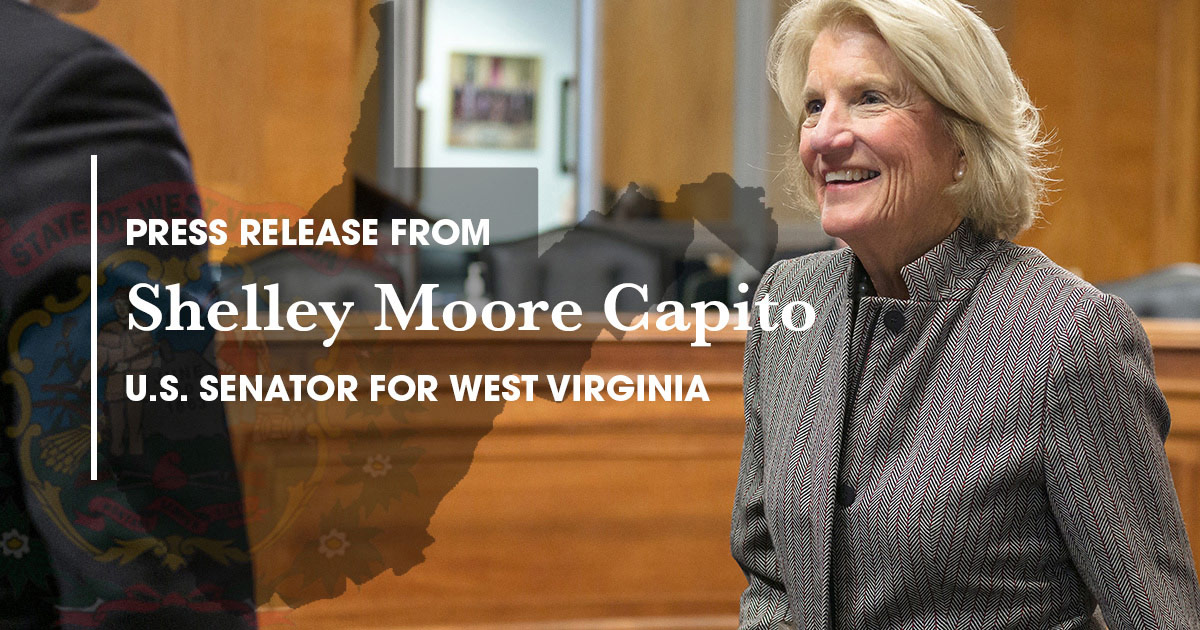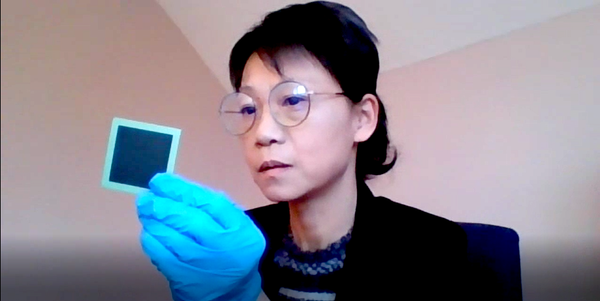
Hydrogen & Clean Energy

News
U.S. Senator Shelley Moore Capito of West Virginia | Capito Secures Grant Funding For West Virginia Programs

August, 2024 - CHARLESTON, W.Va. — Today, U.S. Senator Shelley Moore Capito (R-W.Va.), a member of the Senate Appropriations Committee, announced grants from various federal agencies for projects she helped secure funds for, including healthcare, education, research, environmental cleanup, infrastructure, economic development, and drug use prevention projects.
DOE FUNDING: Senator Capito announced grant funding from the U.S. Department of Energy for a research project at WVU.
• $5,000,000 in DOE funding to WVU (Morgantown, W.Va.) for a project where researchers, in partnership with the National Aeronautics and Space Administration (NASA), aim to demonstrate the advantages of direct solar-thermal integration with hydrogen production via a high-temperature solid oxide electrolyzer, with the goal of transferring the technology to a wide variety of applications, including creating hydrogen and oxygen in space..
capito.senate.gov
JOE MANCHIN | Manchin Announces $5 Million For Solar & Hydrogen Technology Research At WVU

July, 2024 - Washington, DC— Yesterday, Senator Joe Manchin III (I-WV), Chairman of the Senate Committee on Energy and Natural Resources, announced a $5 million research grant from the Department of Energy (DOE) for solar and hydrogen technology research at West Virginia University (WVU).
“Research on solar and hydrogen technologies is critical to advancing the innovation necessary to ensure America’s energy independence in the future while also lowering costs for consumers and reducing emissions,” said Chairman Manchin. “I am so pleased DOE chose WVU for this important investment and remain committed to advocating for resources to cultivate the talent of our state’s incredible researchers.”
The researchers at WVU, in collaboration with the National Aeronautics and Space Administration (NASA), aim to demonstrate using concentrated solar-thermal systems to make low-cost and clean hydrogen. These systems could also be used in a wide variety of other applications, including making oxygen in space.
manchin.senate.gov
Solar Energy Technologies Office | FY23 Solar-thermal Fuels and Thermal Energy Storage Via Concentrated Solar-thermal Energy Funding Program

July, 2024 - The FY23 Solar-thermal Fuels and Thermal Energy Storage Via Concentrated Solar-thermal (CST) Energy funding program awards $33 million for research, development, and demonstration projects produce fuels leveraging the heat from CST and develop low-cost thermal energy storage systems for dispatchable electricity production and continuous use in specified industrial facilities. The U.S. Department of Energy (DOE) Solar Energy Technologies Office (SETO) announced the funding opportunity on September 21, 2023 and announced the selections on July 25, 2024.
WEST VIRGINIA UNIVERSITY
Project Name: Solar-Thermal Bi-reforming of Non-fossil Fuel Methane for Production of Carbon-negative Synthesis Gas
Location: Morgantown, WV
DOE Award Amount: $5 million
Awardee Cost Share: $1.2 million
Principal Investigator: Xueyan Song
Project Description: Researchers, in partnership with the National Aeronautics and Space Administration, aim to demonstrate the advantages of direct solar-thermal integration with hydrogen production via a high-temperature solid oxide electrolyzer, with the goal of transferring the technology to a wide variety of applications, including creating hydrogen and oxygen.
energy.gov
Department of Energy | DOE Announces $33 Million to Deploy Solar Technologies to Decarbonize America’s Industrial Sector

July, 2024 - WASHINGTON, D.C. — In support of the Biden-Harris Administration’s Investing in America agenda, the U.S. Department of Energy (DOE) today announced $33 million for nine projects across seven states to advance concentrating solar-thermal (CST) systems technologies for solar fuel production and long-duration energy storage. CST technologies use mirrors to reflect and concentrate sunlight onto a receiver, helping to produce carbon-free clean fuels, heat, and storage for a wide variety of application. Advancing clean energy technologies like CST is a key component of President Biden’s whole-of-government approach to cutting harmful carbon emissions and essential to achieving the nation’s ambitious clean energy and climate goals.
“Under the Biden-Harris Administration, DOE continues to invest in the next-generation solar technologies we need to tackle the climate crisis and ensure American scientific innovation remains the envy of the world,” said U.S. Secretary of Energy Jennifer M. Granholm. “With today’s announcement, DOE is supporting projects that will harness the sun’s energy to power NASA space missions, beer and wine production, and everything in between.”
DOE’s Solar Futures Study shows that vast amounts of energy storage, with significant growth of long-duration storage in the coming decades, are required to achieve the Biden-Harris Administration’s ambitious clean energy and climate goals…
energy.gov
April 7, 2023 - Since 3/14/2023, this WVU-MAE news is covered by 27 major websites, that are with ~25 million monthly visitors. Those 27 major websites are from 9 countries. Among those websites, the news is covered by major professional societies, including ASHRAE, ASM, and AcerS, which have members from more than 130 countries worldwide.

WVU lab’s game-changing high-performance semiconductor material could help slash heat emissions
Research supported by NSF

Outstanding educators, advisors, staff, researchers and faculty recognized at WVU’s Statler College
April, 2025 - Hailin Li, professor in the Department of Mechanical, Materials and Aerospace Engineering, has been named the College’s Researcher of the Year and Outstanding Researcher at the senior level. Also recognized as Outstanding Researchers at the senior level were associate professor Jeremy Dawson of the computer science and electrical engineering department and Xueyan Song, George B. Berry Chair of Engineering and professor in the mechanical, materials and aerospace engineering department.
Recognized for research at the junior level was Oishi Sanyal, assistant professor in the Department of Chemical and Biomedical Engineering and Wayne and Kathy Richards Faculty Fellow.
media.statler.wvu.edu
The State Journal | New material studied that would reduce 'waste heat' at power plants
April, 2023 - West Virginia University researchers have created a new oxide ceramic material that will dramatically cut down waste heat at power plants, which some officials believe is one of the leading causes of global warming.
Professor Xueyan Song, George B. Berry Chair of Engineering at WVU’s Benjamin M. Statler College of Engineering and Mineral Resources, has a led a team in developing the material in order to reduce the amount of “waste heat” generated by thermoelectric technology anywhere from NASA missions shot into space to heated seats in modern automobiles...
The State Journal
Statler College Media Hub | WVU Researchers Utilize DOE Grant To Design And Create Promising Nanoionics Materials In Energy Technolog

April, 2024 - Researchers at the Benjamin M. Statler College of Engineering and Mineral Resources at West Virginia University have been awarded a $500,000 grant from the US Department of Energy’s Office of Basic Energy Science, to develop nanoionic materials with applications for green hydrogen production, clean electricity generation, biofuel production and wastewater treatment.
media.statler.wvu.edu
WVU Today | WVU students, alumna awarded prestigious NSF graduate fellowships
July, 2023 - Three West Virginia University students and one alumna are joining an elite group of researchers from across the United States as recipients of National Science Foundation Graduate Research Fellowships.
Rachel Morris from Charleston, Meagan Walker from Weston, and Teagan Kuzniar and Ellena Gemmen from Morgantown, will each receive a three-year annual stipend of $37,000 and access to a wide range of professional development opportunities while pursuing research-based master’s and doctoral degrees.
wvutoday.wvu.edu
WVU Today | WVU lab’s game-changing high-performance semiconductor material could help slash heat emissions

March, 2023 - Researchers at West Virginia University have engineered a material with the potential to dramatically cut the amount of heat power plants release into the atmosphere.
A team led by Xueyan Song, professor and George B. Berry Chair of Engineering at the Benjamin M. Statler College of Engineering and Mineral Resources, has created an oxide ceramic material that solves a longstanding efficiency problem plaguing thermoelectric generators. Those devices can generate electricity from heat, including power plant heat emissions, which contribute to global warming.
The breakthrough oxide ceramic Song’s team produced “achieved a record-high performance that had been deemed impossible,” she said. “We demonstrated the best thermoelectric oxide ceramics reported in the field worldwide over the past 20 years, and the results open up new research directions that could further increase performance.”
Cesar Octavio Romo de la Cruz, Yun Chen, Liang Liang and Sergio A. Paredes Navia contributed to the study, supported by $639,784 in National Science Foundation funding. The findings appear in Renewable and Sustainable Energy Reviews...
wvutoday.wvu.edu
Statler College Media Hub | Cosmin Dumitrescu, associate professor of mechanical and aerospace engineering, will serve as the project principal investigator of the third research group that will study “Synergistic Conversion of Captured CO2 and Green H2 to Value-Added Products for a Decarbonized Economy.”

February, 2023 - Cosmin Dumitrescu, associate professor of mechanical and aerospace engineering, will serve as the project principal investigator of the third research group that will study “Synergistic Conversion of Captured CO2 and Green H2 to Value-Added Products for a Decarbonized Economy.” The grant will provide funding ($1.3M) for the group to advance science and engineering around the production of value-added products for a decarbonized and low-carbon West Virginia economy.
Dumitrescu, along with Akkerman, Omid Askari, John Hu, Bingyun Li, Earl Scime and Xueyan Song of WVU, Rodney Tigaa of Concord University and Eyas Mahmoud of West Virginia State University, plan to advance current science and technologies to promote local utilization of captured carbon dioxide and the production of green hydrogen in West Virginia residential, commercial, and industrial sectors.
“The project will promote the local, up-the-value chain, downstream utilization of captured carbon dioxide, coal-fired and natural gas-fired power plants and the production of green hydrogen, thus promoting economic development within the state,” explained Dumitrescu.
The team will work to develop process-intensified modular technologies that will convert captured carbon dioxide and green hydrogen to green ethylene and green ammonia. The production of green ethylene can potentially revive West Virginia’s polymer industry, while green ammonia is an efficient, decarbonized and low emissions alternative to electrification for hard-to-electrify industries.
“Maximizing potential benefits for WV chemical and energy companies requires skilled engineers and operators, appropriate facilities, equipment and partners who would help with technology transfer and economic development,” said Dumitrescu. “With the help of the research challenge grant funding, the project will create an interdisciplinary STEM team dedicated to supporting underrepresented communities and the necessary infrastructure to grow this project’s activities into a vibrant, self-sustaining research and development nucleus for the conversion of carbon dioxide and green hydrogen to value-added products. The project will put WVU in a competitive position in the fields of chemical reaction engineering and advanced combustion science, enabling the university to build a strong multidisciplinary research team and state-of-the-art facilities.”
The awards, which are supported by the Research Challenge Fund that was established by the West Virginia Legislature in 2004 to build research capacity and competitiveness at the state’s colleges and universities, were announced on Friday, February 10 at the Culture Center on the West Virginia State Capitol complex.
media.statler.wvu.edu
Statler College Media Hub | Teaching, advising, research, and staff awards announced in WVU’s Statler college.

April, 2022 - Recipients of the 2021-2022 academic year teaching, advising, research and staff awards (from left to right, top row) Jeremy Dawson, Christopher Griffin, Mario Perhinschi, Udaya Halabe, Sarika Solanki, Lauren Stein, Xin Li and Yu Gu (from left to right, bottom row) Xin Li, Nasser Nasrabadi, Thorsten Wuest, Xueyan Song, Emily Garner, Kathleen Cullen and Susie Huggins.
Pedro Mago, Glen H. Hiner dean of the Statler College of Engineering and Mineral Resources at West Virginia University, announced the winners of the College’s outstanding teaching, advising, research and staff awards for the 2021-2022 academic year on April 1, 2022...
media.statler.wvu.edu
Statler College Media Hub | WVU scientist earns $2.5 million to help pump the brakes on diesel emissions.

August, 2021 - Hailin Li, professor of mechanical and aerospace engineering, earned $2.5 million from the U.S. Department of Energy to develop a software platform that simulates heavy-duty diesel engines in an attempt to cut exhaust emissions.
Hailin Li, professor of mechanical and aerospace engineering, will spearhead the development of a software platform that conducts a fast-integrated simulation of heavy-duty diesel engines, equipped with an advanced after-treatment system. The goal is to speed up new engine technology development to improve engine efficiency...
media.statler.wvu.edu
Statler College Media Hub | WWU engineer receives $1.25 million to fuel a cleaner future through hydrogen.

July, 2021 - Xueyan Song, professor of mechanical and aerospace engineering at WVU, stands next to a machine that measures the conductivity of ceramics. Song was recently awarded $1.25 million for a project aimed at producing a higher amount of hydrogen gas – a clean fuel – with less electric power consumption.
media.statler.wvu.edu
Quoting West Virginia’s Senators, Manchin and Capito, and representative McKinley, from the DOE press release:
"West Virginia University continues to utilize our state's vast natural gas resources to tackle some of the toughest challenges in industrial research, including by developing clean, innovative ways to produce hydrogen – a fuel that's increasingly important to our economy and has potential to decarbonize our energy systems, industrial processes, and the transportation sector," said U.S. Senator Joe Manchin, Chairman of the Senate Energy and Natural Resources Committee. “Today’s announcement is further acknowledgement of the importance of the groundbreaking research conducted by WVU’s students and faculty and the ongoing partnership with the U.S. Department of Energy and National Energy Technology Laboratory. I’m thrilled to see the National Energy Technology Laboratory continue to invest in WVU and I will continue to push for funding that supports research projects in the Mountain State.”
“It’s critical we support an all-of-the-above approach and invest in a variety of technologies, including hydrogen,” said U.S. Senator Shelley Moore Capito. “West Virginia University’s top-notch facilities, students and faculty, and research capacity make it a perfect place to make the most of this investment to develop and accelerate breakthroughs in clean energy.”
“Advancing hydrogen technologies is critical to lowering emissions here at home and around the world,” said U.S. Representative David B. McKinley. “West Virginia University and National Energy Technology Laboratory are at the forefront of hydrogen research and development. Moving forward we must continue to empower our scientific communities through initiatives like the Hydrogen Energy Moonshot to lower the cost of hydrogen and other clean energy technologies.”
energy.gov
Statler College Media Hub Engineering WV Magazine | To Boldly Imagine A New Future

Spring, 2021 - A VISION FOR THE FUTURE
According to Song, a fuel cell is an electrochemical cell that converts the products of a chemical reaction into an electrical current to generate power. The SOFC’s operating temperature is lower than combustion-based processes, limiting the formation of nitrogen and carbon pollutants. In addition, they require approximately one-third of the amount of water relative to conventional combustion-based power systems
media.statler.wvu.edu
Statler College Media Hub | Song named to endowed professorship.

March, 2021 - Xueyan Song, professor of mechanical and aerospace engineering in West Virginia University’s Benjamin M. Statler College of Engineering and Mineral Resources, has been named the George B. Berry Chair of Engineering, effective January 1, 2021.
This designation serves as a college-wide recognition of Song’s past and continuing excellence in research and teaching. Song is the first female in the College to be named to an endowed chair position...
media.statler.wvu.edu
WVU Today | It’s getting hot in here: WVU engineer improves efficiency of U.S. energy infrastructure.

June, 2020 - By rethinking the design of thermoelectric materials, which have the ability to convert heat to electricity, Xueyan Song, a professor of mechanical and aerospace engineering at West Virginia University, is working to develop a method to recover the wasted heat energy from the air, resulting in improved sustainability and efficiency of the energy infrastructure in the U.S.
“Among all kinds of electricity generations, thermoelectric materials can convert the heat or temperature difference in electricity directly and vice versa,” she said...
wvutoday.wvu.edu


































